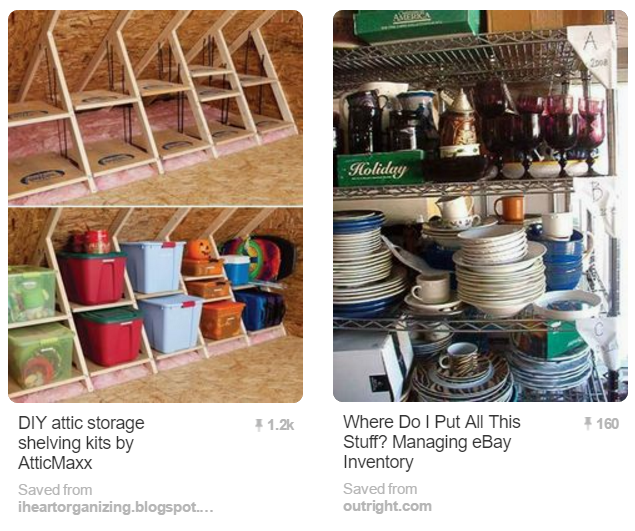
Is it a dream of yours to live full-time off online sales in your eBay store?
There are plenty of examples of people who are doing just that and one of the key things that separates them from the hobbyists is how well they are organized.
In order to grow your business, obviously you will need to scale your operations, including the size of your inventory. Doing so requires a good system. How will you know whether or not something is in stock if you sell several pieces of used clothing each day, for example?
Being organized not only helps you to avoid making mistakes, but it allows you to make more money overall. Here are some tips for keeping your eBay inventory organized:
#1. Have a Dedicated Space
Serious sellers make space for their inventory so that it’s not part of general, everyday clutter. If you’ve got inventory spilling across your living room floor or crammed into your closet with your personal items, it will be difficult to manage, particularly if you want to grow.
You need a space that is solely for your eBay inventory, whether that is in your garage, in a spare bedroom or even by hiring warehouse space if you get really big. A dedicated space not only helps you to keep track of all the items you have available, but it is generally better for ensuring stock is stored properly and breakages are avoided.
#2. Create an Organization System
Alright, you have a space, now how will you keep it organized? This is another crucial piece for being able to scale your business. Generally speaking, the more sales you make, the quicker you will need to be able to fulfill orders, so organization is critical.
There are a number of ways you can go about organizing your inventory, so here are a few ideas:
Create Categories
What makes sense in terms of categories for your items? For example, someone who sells sports memorabilia or fan clothing might categorize their inventory by team or by sport.
A clothing seller might categorize clothes by season, colour or type. The point is that it needs to make sense and make fulfilling orders easier. You want to be able to walk straight to the right area to get the item, with minimal searching.
Create Codes or SKUs
If you have hundreds of items listed on eBay at once, it’s easy to lose track of what you have and what you sold already, especially with unique pieces. Creating unique item codes or SKUs helps you to know exactly what you have in-stock and which “navy winter coat” a customer just ordered. Of course, you will need a management system for tracking these, which we’ll get into further down…
Store for Easy Access
You might have categorized items to store together, but that will be no good if you’re wading through boxes looking for the correct item for an order. No matter which type of item you sell, you need to have a good system of storage that is easy to access.
For example, you could keep shoes in big plastic bins with a list maintained on the outside of the items (and codes) that are in the bin. Clothing may be easier to hang on racks or fold onto shelves with distinctive marks (like T-shirt prints) to the outside. Breakable items might be best stored up high, or pre-packed in protective packaging with an item code on the outside so you know at a glance what is in the box.
There are a number of great ideas to be found on Pinterest for storing your inventory check out a few examples below:


Consider Pre-Packing
There are some sellers who swear by pre-packing inventory as part of their organizational process. Their system is usually something like:
- Receive new inventory.
- Photograph, create descriptions and list the item.
- Assign the item an inventory number, code or SKU.
- Pack into polymail bags ready for shipping, with the code, SKU or item description clearly displayed on the outside.
This may not work for everyone, but it’s worth considering as a way to streamline your fulfillment process afterwards. How much easier would it be to simply weigh and label for postage a parcel that is already packed?
Track your Inventory
At a very basic level, some sellers keep notebooks or Excel spreadsheets to track exactly what inventory they have available and where it is located in storage. The more you have, the more tedious this becomes and of course, because it’s a manual updating process it’s wide open to all sorts of errors.
The alternative is to use inventory tracking software. Some programs are designed more for large businesses and will be too complex and expensive for smaller sellers, but with eBay, Etsy and other open platforms where people sell online, there is software that will suit you.
Here are a couple of examples:
Stitchlabs – This is an inventory management software with an eBay integration. You can integrate multiple channels if you sell in different marketplaces so that it updates inventory in a centralized location. If you sell particular items regularly that you need to keep on hand, they include a forecasting feature for inventory demand, to help prevent any stock-outs.
Shopseen – This software gives you a number options for the size of plan that you need and includes features such as integrating with Instagram stores (for which they take a fee on sales). They also support multi-channel listing across other marketplaces and include social buy buttons among their features.
Both of these options allow you to gain insights that may help you to grow your business further, by providing good reporting features.
#3. Set up a Packing/Shipping Station
Packing and shipping is often one of the most fiddly parts of the entire process. You can burn up a lot more extra mileage than you really need to if you don’t have an area organized as a shipping station.
If you take a leaf out of the book of large operations, such as Amazon FBA, they have shipping stations organized so that there is minimal running around for packers. Your packing materials should be kept at a height where you don’t need to bend over or stretch up too much to reach items quickly.
Keep your shipping tape, protective materials, label refills, printer and scale at your station so that you can develop an efficient rhythm when it comes to packing your orders. It might not be such a big deal while you’re fielding just a few sales, but if you grow into one of the high-volume eBay sellers, every small efficiency counts toward boosting your capacity.
Ready to Get Organized?
Ok, so organizing your inventory may not seem like a thrilling exercise for many sellers, but the fact is if you want to reach the heights of the top sellers, you need to get some kind of system in place early.
Start by ensuring you have a separate storage area for your inventory, so that it’s easier to keep together and avoid mix-ups. Create a system that works for you for easy picking of orders and tracking of exactly what you have.
Finally, keep an organized packing and shipping area so that you’re able to quickly move through multiple orders. A little organization now will create considerable efficiencies later on.









Be the first to leave a comment. Don’t be shy.